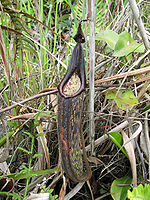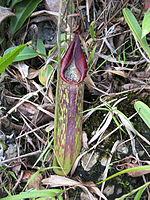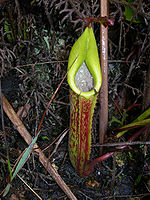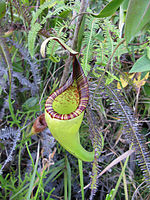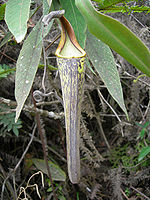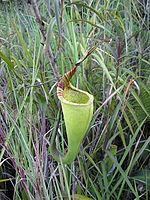- Nepenthes fusca
-
Nepenthes fusca 
An intermediate pitcher of N. fusca
from the Crocker RangeConservation status Scientific classification Kingdom: Plantae (unranked): Angiosperms (unranked): Eudicots (unranked): Core eudicots Order: Caryophyllales Family: Nepenthaceae Genus: Nepenthes Species: N. fusca Binomial name Nepenthes fusca
Danser (1928)[1]Synonyms Heterochresonyms- Nepenthes fusca
auct. non Danser: Sh.Kurata (1976)[5]
[=?N. stenophylla]
Nepenthes fusca (pronounced /nɨˈpɛnθiːz ˈfʌskə/), or the Dusky Pitcher-Plant,[7] is a tropical pitcher plant endemic to Borneo. It is found throughout a wide altitudinal range and is almost always epiphytic in nature, primarily growing in mossy forest.
The specific epithet fusca is derived from the Latin word fuscus, meaning "dark brown" or "dusky", and refers to the colour of the pitchers.[5][7]
Contents
Botanical history
The first known collection of N. fusca was made by Frederik Endert on October 12, 1925, from Mount Kemul in East Kalimantan, at an elevation of 1500 m. It was discovered during an expedition to central Borneo by the Forest Research Institute of Bogor (then known as Buitenzorg),[3] on which Endert also made the only known collection of N. mollis.[8][note a] The N. fusca specimen, designated as Endert 3955, includes male floral material and is deposited at Herbarium Bogoriense (BO), the herbarium of the Bogor Botanical Gardens.[1][9] Endert wrote about this pitcher plant in a detailed 1927 account of the expedition,[3] although he misidentified it as N. veitchii.[1][9]
Nepenthes fusca was formally described[b] in 1928 by Dutch botanist B. H. Danser in his seminal monograph "The Nepenthaceae of the Netherlands Indies".[1] Danser based his description solely on Endert 3955, citing no other specimens. He wrote of N. fusca:[1]
This new species is, together with N. Veitchii and N. stenophylla, very nearly related to N. maxima, but can not be confounded with any of these species. According to Endert it grew in the forest on a narrow, stony mountain ridge covered with humus, and was not rare.
Botanist Jan Schlauer has noted differences between the type specimen of N. fusca and Sabah plants referred to this species,[6] even interpreting plants illustrated in Kurata's Nepenthes of Mount Kinabalu as representing N. stenophylla (as distinct from N. fallax).[9][10][c] Matthew Jebb does not consider these differences significant enough to merit distinction at the species level. He suggests that the type specimen consists of intermediate lower and upper pitchers as opposed to true forms of either, making them appear atypical.[6]
Much of this taxonomic uncertainty stems from the fact that N. fusca has not been recollected from the type locality and many similar plants have been lumped under this taxon.[8] Matthew Jebb and Martin Cheek attempted to resolve this confusion in their 1997 monograph by interpreting N. fusca as a widespread and variable species.[11]
Subspecies
Two subspecies of N. fusca have been described:
- Nepenthes fusca subsp. apoensis J.H.Adam & Wilcock ex Jebb & Cheek (1997)[11] nom.nud. [=N. stenophylla]
- Nepenthes fusca subsp. kostermansiana J.H.Adam & Wilcock ex Jebb & Cheek (1997)[11] nom.nud.
Both were originally coined by J. H. Adam and C. C. Wilcock and subsequently published in Jebb and Cheek's 1997 monograph, "A skeletal revision of Nepenthes (Nepenthaceae)".[11] As these names were published without an adequate description, they are both considered nomina nuda.[9] The former is based on Chai 35939, a specimen collected from Mount Apo.[9] Schlauer considers it synonymous with N. fallax,[9] a taxon that is in turn considered conspecific with N. stenophylla by most authors.[12]
Nepenthes fusca subsp. kostermansiana is thought to be assigned to the correct species. The type specimen (Kostermans 21495) was collected on October 25, 1963, from Kelai River, Mount Njapa, Berau.[9] It is deposited at the National Herbarium of the Netherlands in Leiden.[9]
Nepenthes maxima
Nepenthes maxima, a species native to Sulawesi, New Guinea, and the Maluku Islands, was once thought to extend to Borneo as well. Some authors even wrote that it was widespread on the island.[5][13] This confusion stemmed from the likeness of N. fusca and N. maxima, and from apparently mislabelled seeds collected by Charles Curtis. Curtis was not meticulous in recording where he located individual plants; although it was originally believed that he collected N. curtisii (now considered synonymous with N. maxima)[14] in Borneo, botanist Charles Clarke points out that he also visited Sulawesi on the same trip, and N. maxima is common there.[6]
Matthew Jebb and Martin Cheek resolved this confusion in their 1997 monograph by referring a number of Bornean plants identified as N. maxima to N. fusca, thereby excluding the former from the island.[11]
Nepenthes zakriana
In 1996, J. H. Adam and C. C. Wilcock described Nepenthes curtisii subsp. zakriana.[2][d] Ten years later, Adam and Hafiza A. Hamid elevated it to species status as Nepenthes zakriana (pronounced /nɨˈpɛnθiːz ˌzɑːkriˈænə/, not /ˌzækriˈænə/).[4] The authors described the taxon as a Sabah endemic growing at elevations of 1200 to 1500 m.[4]
Adam and Hafiza wrote that N. zakriana "consistently differed from Nepenthes fusca by prominent raised midribs, extended beyond apex forming an apical glandular appendages on lower lid surface of both upper and lower pitchers; and basal half portion of the midrib developed in nail-shaped glandular crest".[4] However, a number of authors soon voiced their doubts as to whether N. zakriana merited species status[15] and in Pitcher Plants of Borneo by Anthea Phillipps, Anthony Lamb, and Ch'ien Lee, these features were considered to fall within the natural variability of N. fusca.[8]
Nepenthes sp. A
In his 1997 monograph, Nepenthes of Borneo, Charles Clarke lists the undescribed taxon "Nepenthes sp. A", which has been recorded from Gunung Mulu National Park in Sarawak.[6] It bears a close resemblance to N. fusca and may be conspecific with it,[6] although its colouration is unusual for the species.[16] The pitchers of this plant match J. H. Adam and C. C. Wilcock's description[17] of N. faizaliana,[6] but the latter is now known to have a round lid (as opposed to narrowly triangular in N. fusca and "Nepenthes sp. A"), suggesting that these two taxa are not closely related.[6] Clarke proposes that this taxon might fall under Jebb and Cheek's more inclusive concept of N. fusca, but retains it as an undescribed species because it remains poorly known.[6]
"Nepenthes sp. A" was first illustrated in a 1988 article by Anthea Phillipps and Anthony Lamb, where it was considered an undescribed species.[18]
Description
Nepenthes fusca is a climbing plant. The stem may attain a length of 10 m[8] and is up to 8 mm in diameter. Internodes are circular in cross section and up to 7 cm long.[6]
The leaves of this species are petiolate and coriaceous in texture. The lamina or leaf blade is obovate-oblong in shape and measures up to 15 cm in length by 6 cm in width. Its apex is acute to obtuse and may even be slightly peltate. The base of the lamina is gradually attenuate towards the petiole. The petiole (≤4 cm long)[5] is grooved lengthwise and bears a pair of narrow wings that form a semi-amplexicaul sheath around the stem. Up to 3 longitudinal veins are present on either side of the midrib,[5] although they are indistinct. Pinnate veins are numerous. Tendrils measure up to 5 cm in length.[6]
Rosette and lower pitchers are cylindrical throughout. They usually grow to 20 cm in height by 4 cm in width, although exceptional specimens up to 28 cm have been recorded.[8] A pair of fringed wings (≤5 mm wide) runs down the ventral surface of the pitcher and bears fringe elements measuring up to 10 mm and spaced 6 mm apart.[5] The glandular region is restricted to the lower portion of the pitcher's inner surface. The glands are small, overarched, and occur at a density of 600 to 650 per square centimetre.[1] The pitcher mouth is positioned horizontally at the front, becoming elongated into a neck at the rear. The peristome is flattened and expanded (≤12 mm wide), but bears only indistinct teeth (≤0.3 mm long).[5] The pitcher lid or operculum is very narrowly ovate in shape and has a distinctive basal crest on its lower surface. An unbranched spur measuring up to 10 mm in length is inserted near the base of the lid.[6]
Lower pitchers of N. fusca from the Crocker Range (CR) and the area around Mount Kinabalu (MK). From left to right: CR, MK, MK, CR, and CR.Upper pitchers differ markedly in shape, being narrowly infundibular in the lower two-thirds and becoming widely infundibular above. They are similar in size to their lower counterparts, typically measuring up to 18 cm, with some larger forms reaching 26 cm.[8] The tiny digestive glands are overarched and number 1500 to 2000 per square centimetre.[1] The pitcher lid is very narrowly triangular with the margins and apex curved downwards.[8] In aerial pitchers, the wings are reduced to ribs.[6]
Upper pitchers of N. fusca from the Crocker Range (CR) and the area around Mount Kinabalu (MK). From left to right: MK, MK, CR, MK, and CR.Nepenthes fusca produces a compact racemose inflorescence. The peduncle is up to 6 cm long, while the rachis is not known to exceed 10 cm. Partial peduncles are one- or two-flowered, up to 8 mm long, and lack a bract. Sepals are elliptic and up to 4 mm long.[6] A study of 120 pollen samples taken from the type specimen (Endert 3955) found the mean pollen diameter to be 34.8 μm (SE = 0.6; CV = 9.1%).[19]
Developing parts of the plant bear an indumentum of long, brown hairs. However, most of these disappear during the normal course of development, and mature parts only have a sparse covering of short, brown hairs.[6]
Ecology
 Nepenthes fusca, N. reinwardtiana, and N. stenophylla growing in an exposed site along a logging road to Mount Murud in Sarawak
Nepenthes fusca, N. reinwardtiana, and N. stenophylla growing in an exposed site along a logging road to Mount Murud in Sarawak
Nepenthes fusca is endemic to Borneo, where its range stretches from Central Kalimantan to northwestern Sabah.[6] It has been recorded from Brunei, Indonesia (Kalimantan), and Malaysia (Sabah and Sarawak).[20] The species has a wide altitudinal distribution and is typically found at elevations of 1200 to 2500 m above sea level.[6] However, N. fusca has occasionally been reported from lowland hills down to 600 m[21] and in Sarawak it has been found at only 300 m in hill forest.[8]
Nepenthes fusca is most commonly found as an epiphyte in shady mossy forest on ridge tops, where it may grow 10 to 15 m off the ground.[8] This makes it particularly difficult to find and often the only evidence of its presence are dead pitchers that have fallen to the forest floor.[21][22] In this respect, it can be considered the "ecological equivalent" of N. bongso from Sumatra.[23] More rarely, N. fusca grows terrestrially in exposed sites near montane forest[6] or along logging roads.[8] It is often sympatric with species such as N. reinwardtiana, N. stenophylla, and N. tentaculata,[24] and natural hybrids with all of these have been recorded.[8][12]
 Nepenthes fusca from Mount Alab in the Crocker Range
Nepenthes fusca from Mount Alab in the Crocker Range
The species has been recorded from numerous mountains across Borneo. It can be found at several sites on Mount Kinabalu,[25][26] including Kambarangoh, the Marai Parai plateau, the mountain's East Ridge, and the Bambangan River at around 1500 m.[5] It also grows on the side of the road connecting the park headquarters and the power station, despite being frequently cut back as part of road maintenance.[22] This is one of the few places where N. fusca may be easily seen by visitors.[22] These roadside plants were greatly affected by the El Niño climatic phenomenon of 1997 to 1998. The resulting dry period severely depleted the population, such that "almost all the plants were destroyed".[16] Nearby plants from more sheltered locations fared better and appeared to have recovered by the following year.[16] A number of N. fusca plants have also been transplanted to the Mesilau nature trail.[27]
Nepenthes fusca can be viewed along the road leading to the disused Mamut copper mine, where it is sympatric with N. macrovulgaris, N. stenophylla, and the natural hybrid N. fusca × N. stenophylla; N. burbidgeae grows a short distance away.[27]
The species also occurs on nearby Mount Tambuyukon.[5] On Mount Trus Madi, N. fusca has been found at an elevation of almost 1800 m, growing as an epiphyte in Eleocarpus trees.[28] An atypical yellow form grows on Mount Lumarku in Sabah.[8] On Mount Mulu in Sarawak, N. fusca grows below 1200 m, such that its distribution does not overlap with that of two other epiphytes: N. vogelii, which grows from 1200 to 1500 m, and N. hurrelliana, which occurs above 1500 m.[8] Other notable locations include Mount Alab (the highest peak of the Crocker Range), the Kimanis–Keningau Road that runs through the Crocker Range,[8] Mount Njapa (where it grows at 1000 m), and the summit area of Mount Apo Dari (1500 m).[13]
In the Hose Mountains of central Sarawak, N. fusca is typically found growing as an epiphyte in lower montane forest at 700–1200 m.[29] It is also an uncommon inhabitant of roadside embankments there.[29]
Nepenthes fusca is classified as Vulnerable on the 2006 IUCN Red List of Threatened Species, based on an assessment carried out in 2000.[20] This agrees with an informal assessment made by Charles Clarke in 1997, who also classified the species as Vulnerable based on the IUCN criteria. However, Clarke noted that since substantial populations of N. fusca lie within the boundaries of national parks, they "are unlikely to become threatened in the foreseeable future".[6] Taking this into account, he suggested a revised assessment of Conservation Dependent.[6] However, it differs from the assessment by the World Conservation Monitoring Centre, which classified N. fusca as "not threatened", its lowest conservation status.[30]
Related species
Nepenthes fusca is thought to be most closely related to N. hurrelliana, N. platychila, N. stenophylla, and N. vogelii.[8] The enigmatic N. mollis, which some authors have suggested is conspecific with N. hurrelliana,[31] may also be closely allied.
The lower pitchers of N. hurrelliana are distinctive, but the upper ones bear a close resemblance to those of N. fusca. Of the Bornean pitcher plant flora, only these two species have such a narrowly triangular lid. The upper pitchers of N. hurrelliana differ in having a horizontal mouth that rises abruptly into a long neck at the back and in having a hirsute basal crest on the underside of the lid.[8]
Nepenthes hurrelliana is particularly similar to a form of N. fusca from the southern portion of the Crocker Range in Sabah. This form exhibits a wider peristome, longer neck, and a more triangular lid than most other examples of the species.[8] However, the peristome is still not as well developed as in N. hurrelliana and the plant lacks the dense indumentum of the latter. Furthermore, N. hurrelliana differs in the distribution of nectar glands on the lower surface of its lid.[8]
The first known collection of N. vogelii, made in 1961, was labelled as N. fusca.[8] In 1969, botanist Shigeo Kurata examined this specimen and noted that it did not fall within the known variation exhibited by N. fusca.[8] Nevertheless, the species remained undescribed until 2002.[32] Nepenthes vogelii differs in having much smaller pitchers and lacking appendages on the underside of the lid.[32] In addition, the lid of N. vogelii is broadly triangular as opposed to the narrowly triangular lid of N. fusca.[8][21] The colour of the pitchers—light cream with dark speckles—is also distinctive.[21]
Nepenthes faizaliana also bears a resemblance to N. fusca. In their description of the former, J. H. Adam and C. C. Wilcock distinguished these taxa on the basis of inflorescence structure, the size of the glandular region on the inner surface of upper pitchers, and the development and characteristics of the indumentum.[6][17] In addition, N. fusca differs in having a very narrow pitcher lid, as opposed to the orbicular lid of N. faizaliana.[6]
Nepenthes platychila can be distinguished from N. fusca on the basis of its much wider peristome and lid, the latter lacking appendages on its lower surface.[8] Nepenthes fusca is also thought to be closely related to Sulawesi's N. eymae, and N. maxima, which is widespread in Sulawesi, New Guinea, and the Maluku Islands.[33]
Natural hybrids
Due its widespread distribution throughout Borneo, N. fusca forms natural hybrids with a relatively large number of other species. However, like N. fusca itself, these are often hard to find due to the species's epiphytic growth habit.[8]
 Lower pitchers of N. burbidgeae × N. fusca from Mesilau
Lower pitchers of N. burbidgeae × N. fusca from Mesilau
N. burbidgeae × N. fusca
Nepenthes burbidgeae × N. fusca has been known since at least the early 1980s, when it was found during an expedition to Sabah.[24]
N. fusca × N. lowii
This hybrid was initially identified as a cross with N. chaniana (known as N. pilosa at the time)[34] by Charles Clarke.[6] However, Anthea Phillipps, Anthony Lamb, and Ch'ien Lee differ in their interpretation, noting that the plant exhibits influences of N. fusca, such as a triangular lid and an elongated neck.[8] They write that both N. fusca and N. lowii are common in the summit area, whereas N. chaniana is rare.[8] Another possible parent species, N. stenophylla, is apparently absent from the site.[8]
Nepenthes fusca × N. lowii was discovered by Rob Cantley and Charles Clarke on Bukit Batu Lawi in Sarawak.[6] Clarke later found larger plants of this hybrid in the Crocker Range of Sabah, particularly near the summit of Mount Alab.[6] The pitchers of N. fusca × N. lowii have a slight constriction in the middle and range in colour from green to dark purple throughout.[6]
This hybrid differs from N. fusca in the presence of bristles on the underside of the lid. Conversely, it has a dense indumentum on the stem and at the margins of the lamina, compared to the virtually glabrous stem and leaves of N. lowii. It also differs from N. lowii in having a more developed peristome, which is circular in cross section. While lower pitchers of N. lowii have prominent teeth, those of N. fusca × N. lowii are indistinct. In addition, a glandular appendage is present on the underside of the lid,[6] a trait inherited from N. fusca.
Nepenthes fusca × N. lowii is difficult to confuse with its putative parent species, but is somewhat similar to N. chaniana × N. veitchii. The latter hybrid can be distinguished on the basis of its peristome, which is wider, more flared, and less cylindrical. In addition, this hybrid has a less ovate lid, which lacks the bristles characteristic of N. lowii, and a denser indumentum covering the stem and leaves.[6]
N. fusca × N. reinwardtiana
A putative cross between N. fusca and N. reinwardtiana has been recorded.[12] N. naquiyuddinii is generally thought to be a heterotypic synonym of N. reinwardtiana,[15] but may also represent this hybrid, as both putative parent species grow in close proximity to it.[8]
N. fusca × N. stenophylla
This hybrid is known from the eastern slopes of Mount Trus Madi, where it grows in lower montane forest. Both N. fusca and N. stenophylla are common in this area.[8] It has also been recorded from the Mamut copper mine.[27] It more closely resembles N. stenophylla, but differs in the shape of the lid, which is more oval-shaped.[8]
N. fusca × N. tentaculata
Nepenthes fusca × N. tentaculata was discovered by Linus Gokusing near the summit of Mount Alab, where it grows in upper montane forest at elevations of around 1800 to 2000 m.[8] It is sympatric with both parent species, which are abundant in the area.[8]
Other hybrids
In addition, crosses with N. platychila,[35] N. rajah,[6] and N. veitchii[6] have been recorded.
The pitchers of N. hurrelliana are roughly intermediate in appearance between those of N. fusca and N. veitchii. This has led to speculation regarding the lineage of this species, with a number of authors suggesting a possible hybridogenic origin.[21] However, N. hurrelliana is distinct from the natural hybrid N. fusca × N. veitchii and most authors now regard it as a valid species.[8][21][36]
Cultivation
 In the wild, N. fusca is generally found is rather shady conditions (upper pitchers growing along a logging road to Mount Murud pictured) and this preference is reflected in cultivated plants, which show optimal growth under lower light levels than many other Nepenthes species.[37]
In the wild, N. fusca is generally found is rather shady conditions (upper pitchers growing along a logging road to Mount Murud pictured) and this preference is reflected in cultivated plants, which show optimal growth under lower light levels than many other Nepenthes species.[37]
Little information has been published on the growing requirements of N. fusca. In 2004, professional horticulturist Robert Sacilotto wrote an article for the Carnivorous Plant Newsletter, summarising measured tolerances of several highland Nepenthes species based on experiments conducted between 1996 and 2001.[37]
Sacilotto found N. fusca to be tolerant of a wide range of conditions; with the exception of plants not treated with fungicides, no test groups showed a survival rate of less than 75%. Nepenthes fusca was found to tolerate temperatures in the range of 10 to 38 °C (50 to 100 °F). A nighttime drop in temperature below 21 °C (70 °F) was necessary for good growth; plants that were not exposed to such a drop grew poorly and produced fewer pitchers. The experiments suggested that N. fusca grows best when relative humidity is in the range of 65 to 90%.[37]
The species seemed to do best in growing media with a high proportion of organic matter (such as a mixture consisting of 10% peat moss chunks, 30% perlite, and 60% of any combination of Sphagnum moss and fir bark). Soil with a slightly acidic pH of 4.5 to 5.0 produced the best results. Optimal soil conductivity appeared to lie between 10 and 45 microsiemens.[37]
An illuminance of 6400–8600 lx (600–800 fc) proved to be optimal when plants were grown under sunlight, high pressure sodium, and metal halide lamps. However, specimens placed under an even combination of Gro-Lux and cool white fluorescent lamps at 5400–7500 lx (500–700 fc) exhibited the most vibrant colours (although growth rates remained the same). Plants moved from the former to the latter light set up showed a significant change in pigmentation; green leaf blades turned bronzy and speckles on the pitchers darkened markedly.[37]
Nepenthes fusca was found to respond well to a quarter-strength fertilizer that was applied to the pitchers. Ants were also an effective food source.[37]
Notes
- a.^ During September and October 1925, Endert explored the hilly area around Mount Kemul, climbing the summit (1,847 m) several times, and the neighbouring valleys of the Long Mehiang, Long Kiau, and Long Petak.[38] He collected N. fusca on October 12 and N. mollis on October 17.[1]
b.^ The Latin description of N. fusca from Danser's monograph reads:[1]
Folia mediocria breviter petiolata, lamina lanceolata, nervis longitudinalibus utrinque c. 2, vagina caulis 1/2 amplectente; ascidia rosularum ignota; ascidia inferiora magnitudine mediocria, parte inferiore anguste ovata, os versus subcylindrica, parte superiore alis 2 fimbriatis; peristomio in collum elongato, applanato, 4-10 mm lato, costis c. 1/3-2/3 mm distantibus, dentibus c. tam longis quam latis; operculo anguste ovato, subcordato, facie inferiore appendice lateraliter applanata; ascidia superiora magnitudine mediocria, infundibuliformia, costis 2 prominentibus; peristomio in collum elongato, applanato, 3-8 mm lato, costis 1/3-1/4 mm distantibus, dentibus brevissimis; operculo anguste ovato, subcordato, facie inferiore prope basin appendice lateraliter applanata; inflorescentia racemis parvus, pedicillis inferioribus c. 8 mm longis, omnibus 1-floris v. partim 2-floris ; indumentum iuventute densissimum, denique passim densum, breve, e pilis patentibus crassis simplicibus v. basi ramosis compositum.
c.^ Some authors treat N. fallax in synonymy with N. stenophylla,[11][6] while others consider them to be two distinct species, with plants commonly referred to as N. stenophylla actually representing N. fallax.[39]
d.^ The subspecies was named after A. H. Zakri,[4] Director of the United Nations University Institute of Advanced Studies. This taxon, along with N. curtisii (sensu J.H.Adam & Wilcock) itself, is considered a heterotypic synonym of N. stenophylla by some taxonomists.[14]
References
- ^ a b c d e f g h i Danser, B.H. 1928. 13. Nepenthes fusca Dans., nova spec.. In: The Nepenthaceae of the Netherlands Indies. Bulletin du Jardin Botanique de Buitenzorg, Série III, 9(3–4): 249–438.
- ^ a b Adam, J.H. & C.C. Wilcock 1998 ['1996']. Pitcher plants of Mt. Kinabalu in Sabah. The Sarawak Museum Journal 50(71): 145–171.
- ^ a b c (Dutch) Endert, F.H. 1927. Botanisch en floristisch verslag. In: D.W. Buijs, H. Witkkamp, F.H. Endert, H.C. Siebers & D.F.K. Bosch. Midden-Oost-Borneo Expeditie 1925. G. Kolff & Co., Weltevreden.
- ^ a b c d e Adam, J.H. & Hafiza A. Hamid 2006. Pitcher plants (Nepenthes) recorded from Keningau-Kimanis Road in Sabah, Malaysia.PDF (2.40 MiB) International Journal of Botany 2(4): 431-436. ISSN 1811-9700 doi:10.3923/ijb.2006.431.436
- ^ a b c d e f g h i Kurata, S. 1976. Nepenthes of Mount Kinabalu. Sabah National Parks Publications No. 2, Sabah National Parks Trustees, Kota Kinabalu.
- ^ a b c d e f g h i j k l m n o p q r s t u v w x y z aa ab ac ad ae Clarke, C.M. 1997. Nepenthes of Borneo. Natural History Publications (Borneo), Kota Kinabalu.
- ^ a b Phillipps, A. & A. Lamb 1996. Pitcher-Plants of Borneo. Natural History Publications (Borneo), Kota Kinabalu.
- ^ a b c d e f g h i j k l m n o p q r s t u v w x y z aa ab ac ad ae af Phillips, A., A. Lamb & C.C. Lee 2008. Pitcher Plants of Borneo. Second Edition. Natural History Publications (Borneo), Kota Kinabalu.
- ^ a b c d e f g h Schlauer, J. N.d. Nepenthes fusca. Carnivorous Plant Database.
- ^ Clarke, C.M. 2006. Introduction. In: Danser, B.H. The Nepenthaceae of the Netherlands Indies. Natural History Publications (Borneo), Kota Kinabalu. pp. 1–15.
- ^ a b c d e f Jebb, M.H.P. & M.R. Cheek 1997. A skeletal revision of Nepenthes (Nepenthaceae). Blumea 42(1): 1–106.
- ^ a b c McPherson, S.R. 2009. Pitcher Plants of the Old World. 2 volumes. Redfern Natural History Productions, Poole.
- ^ a b Adam, J.H., C.C. Wilcock & M.D. Swaine 1992. The ecology and distribution of Bornean Nepenthes.PDF Journal of Tropical Forest Science 5(1): 13–25.
- ^ a b Schlauer, J. N.d. Nepenthes curtisii. Carnivorous Plant Database.
- ^ a b Rice, B.A. 2006. Do you want to tell me about a species I missed? The Carnivorous Plant FAQ.
- ^ a b c Steiner, H. 2002. Borneo: Its Mountains and Lowlands with their Pitcher Plants. Toihaan Publishing Company, Kota Kinabalu.
- ^ a b Adam, J.H. & C.C. Wilcock 1991. A new species of Nepenthes (Nepenthaceae) from Sarawak. Blumea 36(1): 123–125.
- ^ Phillipps, A. & A. Lamb 1988. Pitcher-plants of East Malaysia and Brunei. Nature Malaysiana 13(4): 8–27.
- ^ Adam, J.H. & C.C. Wilcock 1999. Palynological study of Bornean Nepenthes (Nepenthaceae).PDF Pertanika Journal of Tropical Agricultural Science 22(1): 1–7.
- ^ a b Schnell, D., P. Catling, G. Folkerts, C. Frost, R. Gardner, et al. 2000. Nepenthes fusca. 2006 IUCN Red List of Threatened Species. IUCN 2006. Retrieved on 11 May 2006. Listed as Vulnerable (VU C2 v2.3).
- ^ a b c d e f Clarke, C.M. & C.C. Lee 2004. Pitcher Plants of Sarawak. Natural History Publications (Borneo), Kota Kinabalu.
- ^ a b c Clarke, C.M. 2001. A Guide to the Pitcher Plants of Sabah. Natural History Publications (Borneo), Kota Kinabalu.
- ^ Clarke, C.M. 2001. Nepenthes of Sumatra and Peninsular Malaysia. Natural History Publications (Borneo), Kota Kinabalu.
- ^ a b Lowrie, A. 1983. Sabah Nepenthes Expeditions 1982 & 1983.PDF Carnivorous Plant Newsletter 12(4): 88–95.
- ^ Triplitt, R. 1985. Nepenthes—Color Them Unique.PDF Carnivorous Plant Newsletter 14(2): 40–42, 48–49.
- ^ Malouf, P. 1995. A visit to Kinabalu Park.PDF Carnivorous Plant Newsletter 24(3): 64–69.
- ^ a b c Thong, J. 2006. Travels around North Borneo – Part 1.PDF Victorian Carnivorous Plant Society Journal 81: 12–17.
- ^ Marabini, J. 1984. A Field Trip to Gunong Trusmadi.PDF (442 KiB) Carnivorous Plant Newsletter 13(2): 38–40.
- ^ a b Lee, C.C. 2002. Nepenthes species of the Hose Mountains in Sarawak, Borneo.PDF Proceedings of the 4th International Carnivorous Plant Conference, Hiroshima University, Tokyo: 25–30.
- ^ Simpson, R.B. 1995. Nepenthes and conservation. Curtis's Botanical Magazine 12: 111–118.
- ^ Salmon, B.[R.] 1999. Nepenthes mollis (Nepenthaceae)—Rediscovered?PDF (561 KiB) Carnivorous Plant Newsletter 28(1): 24–26.
- ^ a b Schuiteman, A. & E.F. de Vogel 2002. Nepenthes vogelii (Nepenthaceae): a new species from Sarawak. Blumea 47(3): 537–540.
- ^ D'Amato, P. 1993. Nepenthes eymai.PDF Carnivorous Plant Newsletter 22(1–2): 21.
- ^ Clarke, C.M., C.C. Lee & S. McPherson 2006. Nepenthes chaniana (Nepenthaceae), a new species from north-western Borneo. Sabah Parks Journal 7: 53–66.
- ^ Lee, C.C. 2002. Nepenthes platychila (Nepenthaceae), a new species of pitcher plant from Sarawak, Borneo. The Gardens' Bulletin Singapore 54: 257–261.
- ^ Cheek, M., M. Jebb, C.C. Lee, A. Lamb & A. Phillipps. 2003. Nepenthes hurrelliana (Nepenthaceae), a new species of pitcher plant from Borneo. Sabah Parks Nature Journal 6: 117–124.
- ^ a b c d e f Sacilotto, R. 2004. Experiments with highland Nepenthes seedlings: a summary of measured tolerances. Carnivorous Plant Newsletter 33(1): 26–31.
- ^ van Steenis-Kruseman, M.J., et al. 2006. Cyclopaedia of Malesian Collectors: Frederik Hendrik Endert. Nationaal Herbarium Nederland.
- ^ Schlauer, J. N.d. Nepenthes fallax. Carnivorous Plant Database.
- Beaman, J.H. & C. Anderson 2004. The Plants of Mount Kinabalu: 5. Dicotyledon Families Magnoliaceae to Winteraceae. Natural History Publications (Borneo), Kota Kinabalu.
- Bonhomme, V., H. Pelloux-Prayer, E. Jousselin, Y. Forterre, J.-J. Labat & L. Gaume 2011. Slippery or sticky? Functional diversity in the trapping strategy of Nepenthes carnivorous plants. New Phytologist 191(2): 545–554. doi:10.1111/j.1469-8137.2011.03696.x
- Bourke, G. 2011. The Nepenthes of Mulu National Park. Carniflora Australis 8(1): 20–31.
- Kurata, S. 1969. Mindoro/North Borneo Expedition. Part 3. Journal of Insectivorous Plant Society No. 47.
- Thorogood, C. 2010. The Malaysian Nepenthes: Evolutionary and Taxonomic Perspectives. Nova Science Publishers, New York.
External links
Incompletely diagnosed taxa: N. sp. Misool • N. sp. Papua • N. sp. Sulawesi
Possible extinct species: N. echinatus • N. echinosporus • N. majorCategories:- IUCN Red List vulnerable species
- Carnivorous plants of Asia
- Nepenthes
- Flora of Borneo
- Plants described in 1928
- Endemic flora
- Vulnerable plants
- Epiphytes
- Nepenthes fusca
Wikimedia Foundation. 2010.






